Ecommerce marketplaces are gaining momentum, fast. We’re all familiar with the saying, “Go where your customers are.” These days, consumers are flocking to marketplaces like Amazon, eBay, Alibaba, Walmart, and Rakuten to do their shopping.
Last year, global ecommerce sales amounted to more than $5.8 trillion worldwide. In 2027, sales are expected to rise to over $8 trillion.
Selling on a marketplace can help build your brand, provide convenient shopping experiences for consumers, and multiply your profits. The opportunities are great, but expanding into global markets can come with complexities.
What is an ecommerce marketplace?
A marketplace is an online platform that hosts products from different sellers. Companies that operate as a marketplace, like Amazon or eBay, do not own any inventory.
Types of ecommerce marketplaces
There are four main types of marketplaces:
- Product-based marketplaces: Shoppers can buy physical products from various sellers. Examples include Amazon and AliExpress.
- Service-based marketplaces: Clients can find and hire service providers like freelancers or independent contractors. Examples include Upwork and TaskRabbit.
- Peer-to-peer marketplaces: Individuals can buy and sell products and services with each other. Examples include Etsy, Facebook Marketplace, and eBay.
- B2B marketplaces: Businesses can buy and sell products and services with other businesses. Examples include Alibaba and Thomasnet.
Marketplace vs. ecommerce store
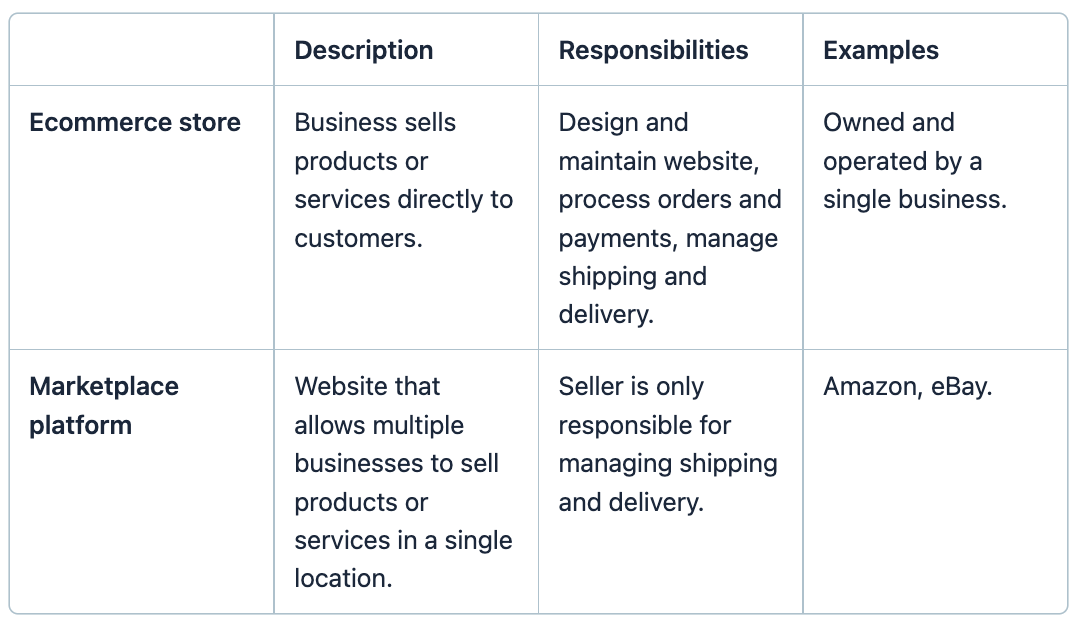
- Marketplaces give customers access to multiple retailers in one place. . In a marketplace, products are categorized and presented in a way that encourages views and sales. Ecommerce shoppers can compare options from many different brands in an instant. To make the payment process as easy as possible, these platforms usually offer express checkout.
- Ecommerce stores allow businesses to sell their products or services online directly to customers. A business is responsible for maintaining and designing its ecommerce website, processing orders and payments, and managing product shipping and delivery.
In general, an ecommerce store is owned and operated by a single business, while a marketplace platform enables multiple businesses to sell to customers in one place.
12 top ecommerce marketplaces
1. Amazon
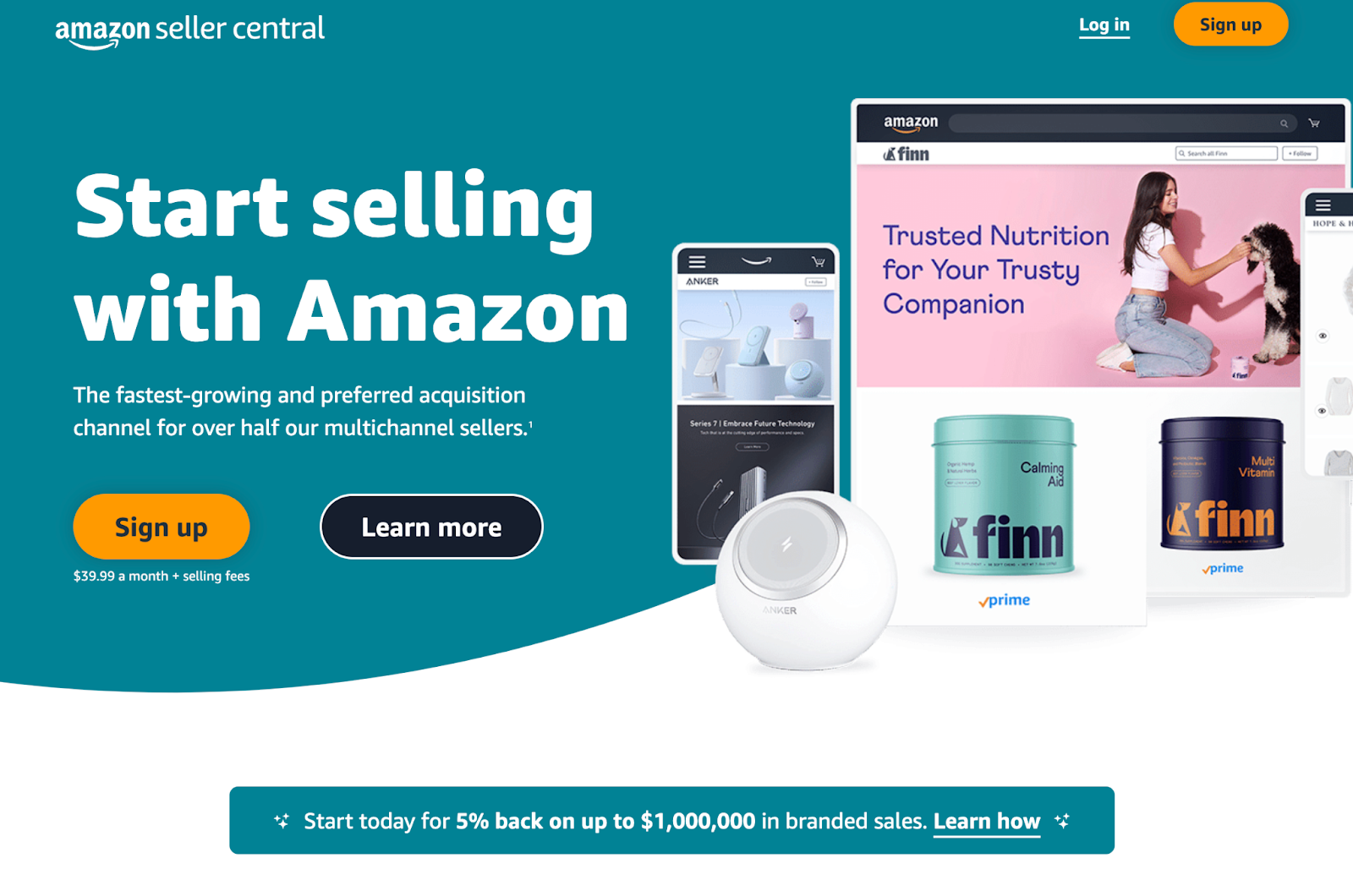
Amazon is the world's most popular marketplace, thanks to its powerful shipping and fulfillment functions and consistent shopping experience. It is also the world’s second-largest search engine.
Before you can create Amazon Store content, you’ll need to register your brand using Amazon’s Brand Registry.
Once your brand is registered, you can set up your first Amazon Store. Select your theme and start to build out your pages, much like you would with your own website, making sure that the navigation is simple enough for customers to find what they’re looking for easily.
Monthly visits:2.7 billion
Fees: Varies by category, but averages 15% per sale.
Top regions: United States, Germany, United Kingdom, Japan
Top categories: Home and kitchen; beauty and personal care; toys and games; clothing, shoes, and jewelry; health, household, and baby
2. eBay
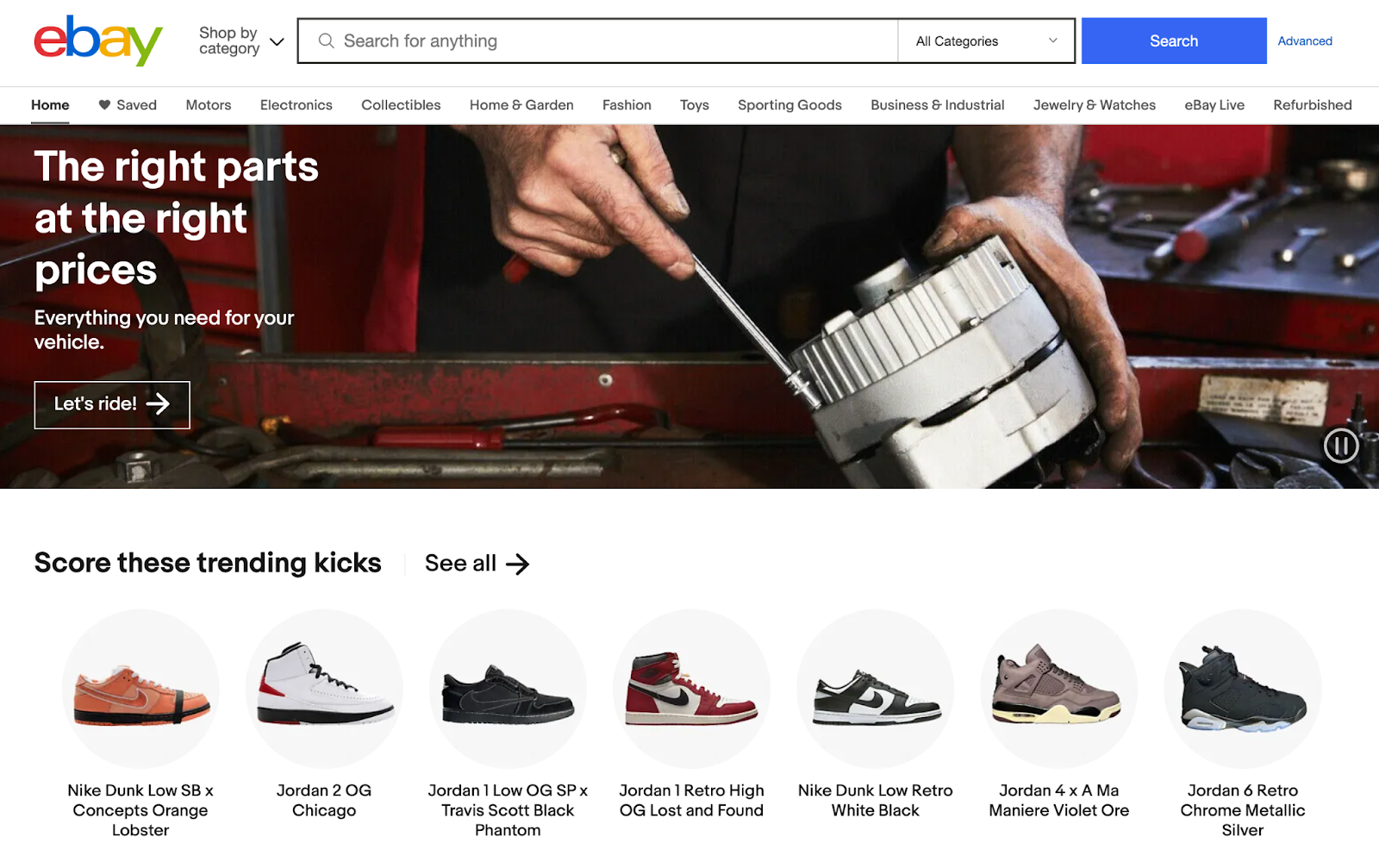
eBay isn’t just an online auction house for used items: Many of the products listed on eBay are actually new. The flexibility for retailers to sell new and used has allowed eBay to earn $10.1 billion in 2022.
With the eBay channel on Shopify (available in the US, Canada, Australia, the UK, and Germany), you can expand your reach to the 138 million users who shop the platform’s listings.
To sell on eBay, there are three basic steps:
- Sign up for an eBay business selling account.
- Set up your account policies, including shipping, return, and policy preferences.
- Upload your inventory using eBay’s tools.
With eBay, there are five different pricing plans, with each higher level offering more tools, reduced selling fees, “promoted listing” credits, and more. Choose a pricing structure appropriate for the size of your ecommerce business.
Monthly visits:594.8 million
Fees: Final value fee calculated as a percentage of the final sale price, up to 14.35%, plus a $0.30 processing fee
Top regions: United States, United Kingdom, Germany, China, Australia
Top categories: Electronics and accessories; automotive; jewelry and watches; collectibles
3. Walmart
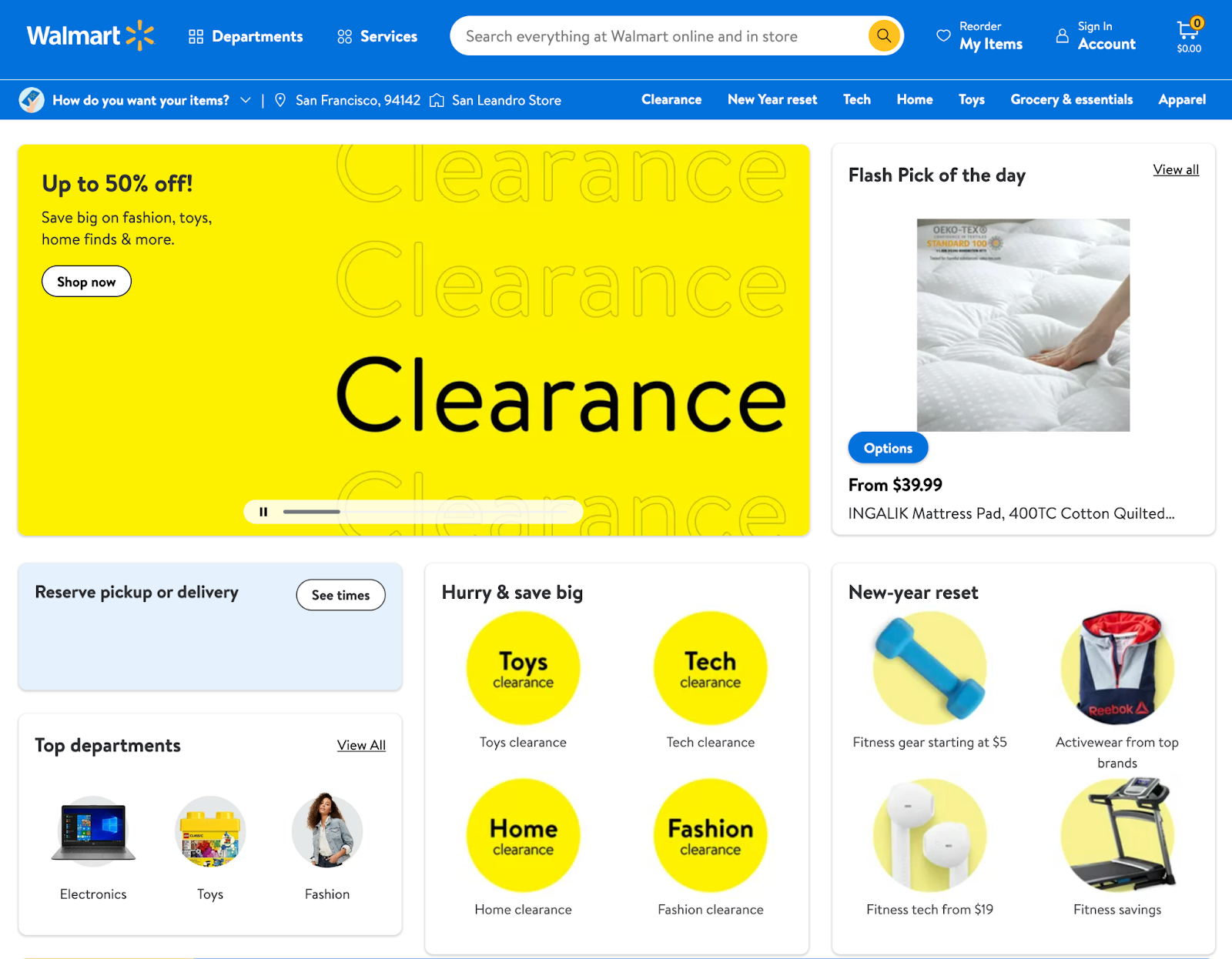
Walmart is now the third-most-visited online retailer in the US, with over half a million visitors each month.
Walmart currently allows third-party sellers to sell their products in more than 35 product categories on its marketplace. Around 5% of Walmart’s current marketplace sellers are based outside the US.
To sell on Walmart as a partner you need to follow these five steps:
- Tell Walmart about your businesses and the products you’re planning to sell.
- Once you’ve been approved, set up your seller account.
- Sign the Walmart Retailer Agreement and complete your seller profile.
- Onboard with a choice of integration methods, add your items, and test orders.
- Click the Ready to Launch button, after which Walmart will complete a final review before you can start selling.
As part of the onboarding process, you can now connect your Shopify store with Walmart.com’s Marketplace website, if approved. The app will allow you to upload your product catalog and create listings, sync inventory, and import order details for fulfillment with Shopify. To date, this is only available for brands that are based in the US.
Monthly visits: 1.34 billion
Fees: Commission fees vary between 6% and 15%.
Top regions: United States, Canada, India
Top categories: Electronics, toys, fashion
4. Alibaba
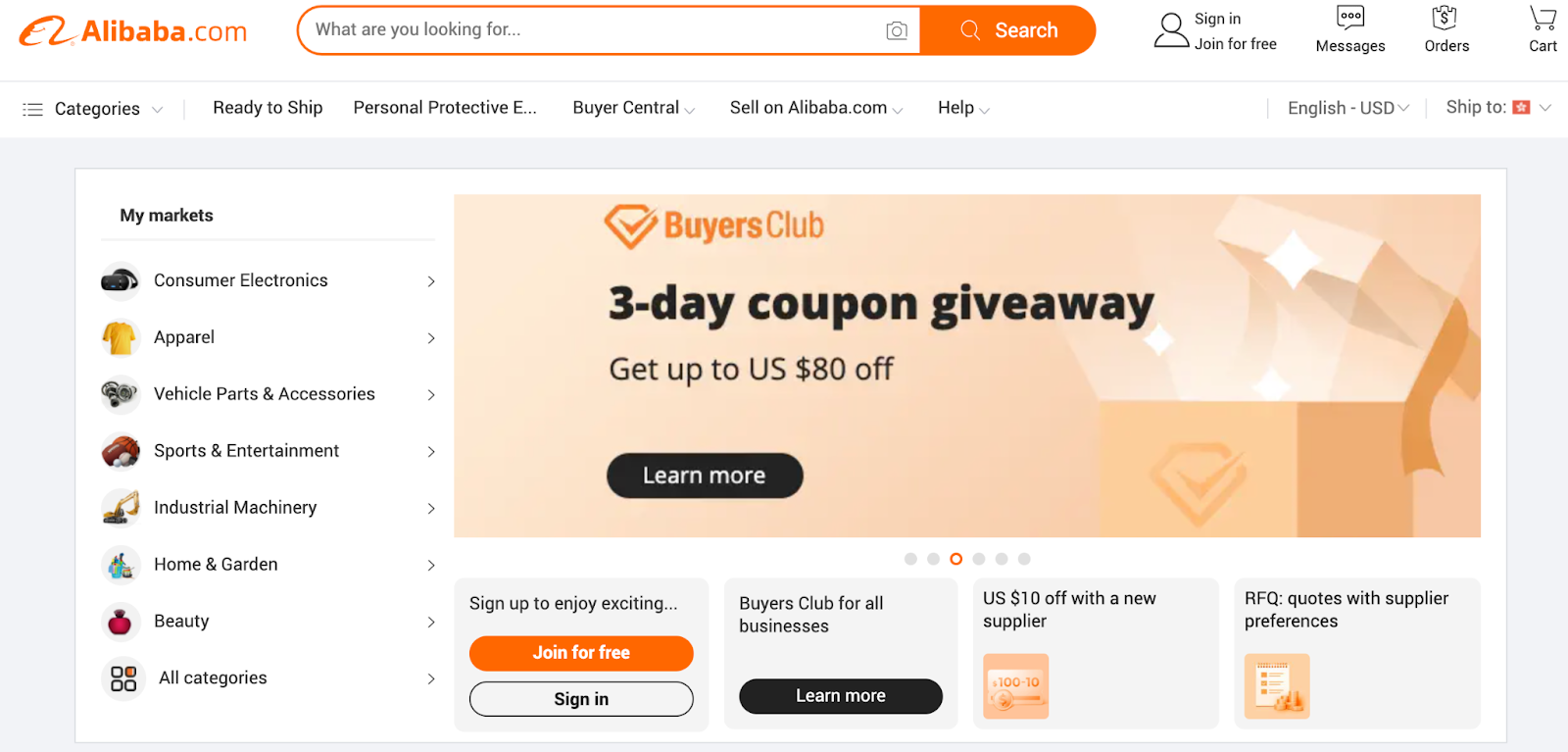
As the leading ecommerce provider in China, Alibaba is one of the best online marketplaces for B2B sellers.
As a business-to-business (B2B) manufacturer and wholesale supplier, Alibaba.com provides the foundation for many businesses, not just in China. So if your business is about selling products to other businesses, look no further than Alibaba.com.
To start selling with Alibaba, you’ll just need to fill out a simple form to create an account.
Monthly visits: 218.5 million
Fees: Seller plans start at $3,499 per year.
Top regions: China, United States, Russia, United Kingdom
Top categories: Electronic consumer; sports and entertainment; beauty and personal care; tools and equipment
5. AliExpress
 AliExpress is a subsidiary of the China-based Alibaba Group and one of its established marketplaces in the B2C space.
AliExpress is a subsidiary of the China-based Alibaba Group and one of its established marketplaces in the B2C space.
What makes AliExpress a great option for many businesses is its localization—the platform is available in 18 languages in 230 countries and regions. It’s a common marketplace for dropshipping companies, because many suppliers ship directly to consumers for affordable fees.
Selling on AliExpress is as easy as selling on many other platforms: Create an account, enter your information, then submit your application. After that, you can personalize your store and start selling.
Monthly visits: 1.69 billion
Fees: Commissions vary between 5% and 8%.
Top regions: China, Brazil, Spain, United States, France, Korea
Top categories: Consumer electronics; health and beauty; home and garden; women’s clothing; mom and kids
6. Taobao
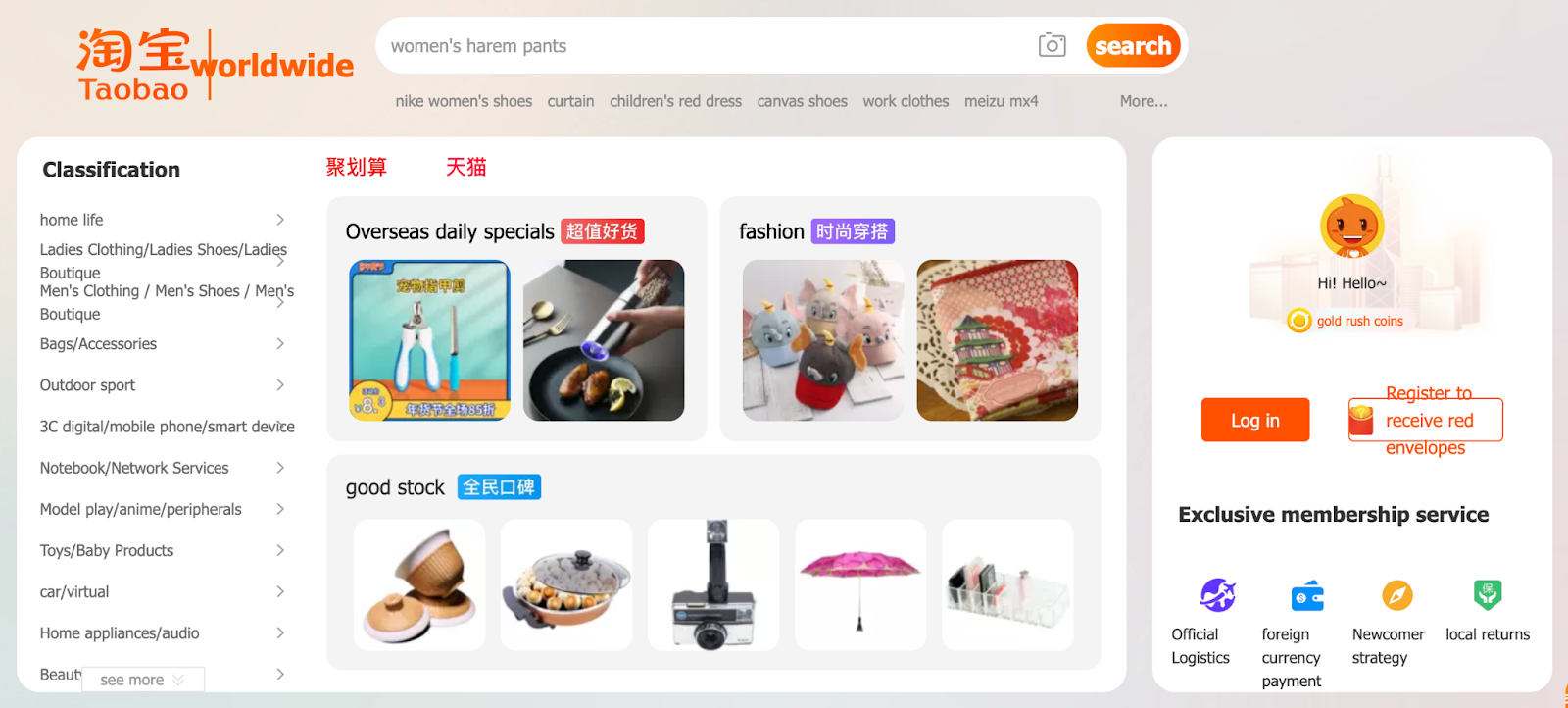
Formed in 2003 by Jack Ma, Taobao is a leading ecommerce marketplace in China as of April 2023. What separates Taobao from AliExpress is that its business model is primarily consumer to consumer (C2C)—think of it as the eBay of China.
Monthly visits: 551.4 million
Fees: None
Top regions: China, Taiwan, Hong Kong, United States, Singapore
Top categories: Women's clothing, cosmetics, jewelry, home furnishing
7. Flipkart
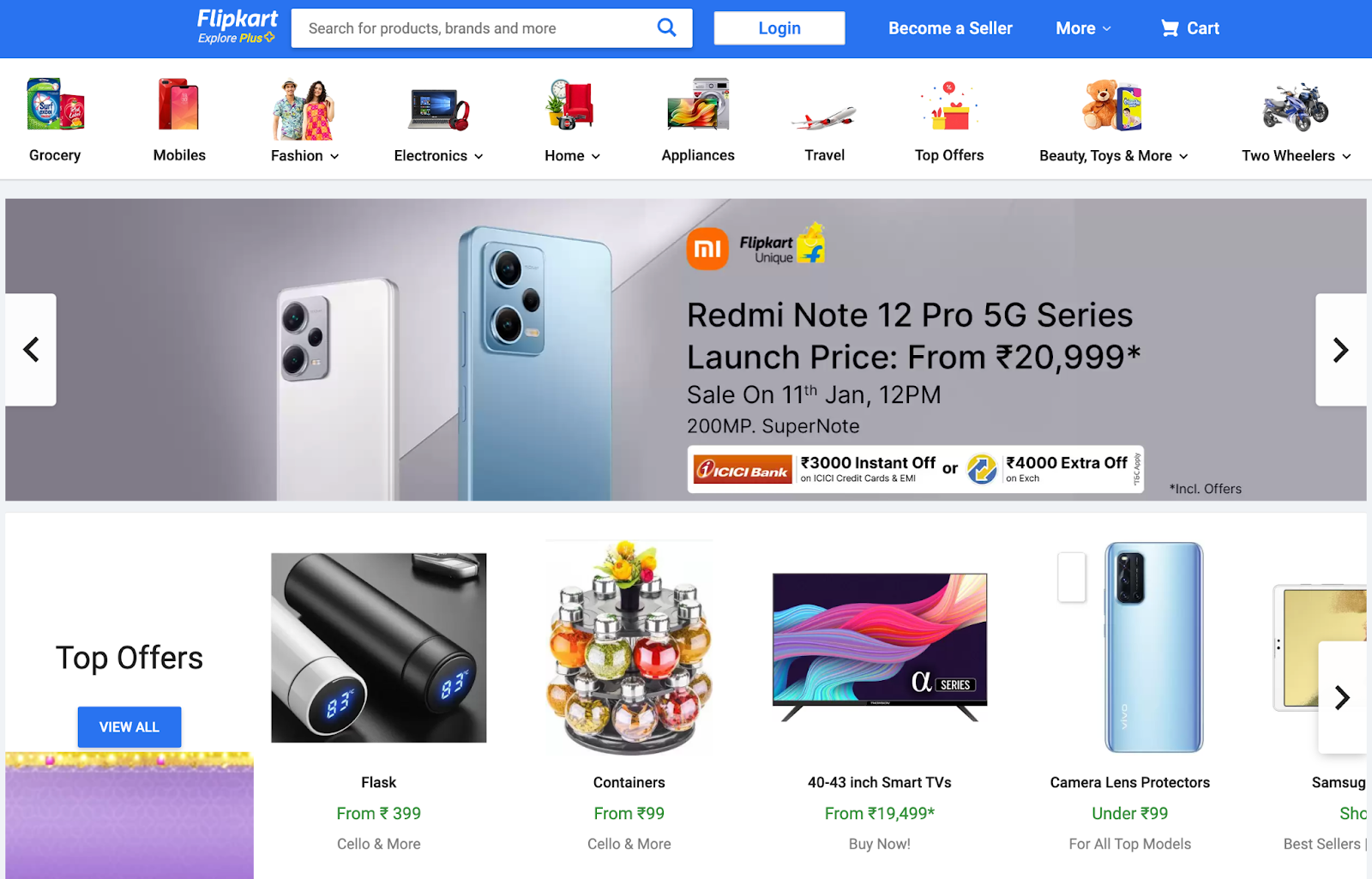
Flipkart is an ecommerce company based in Bengaluru, India, and was acquired by Walmart in 2018.
The company was founded by previous Amazon employees in October 2007, launching a proprietary product line called DigiFlip that included laptop bags and tablets, and has since expanded into other product categories like furniture, grocery, travel, and beauty.
Monthly visits: 635.2 million
Fees: Rates vary from 2.8% to 25%
Top regions: India, United States, United Arab Emirates, United Kingdom
Top categories: Electronics; home and kitchen; fashion; books; and health and beauty products
8. Rakuten
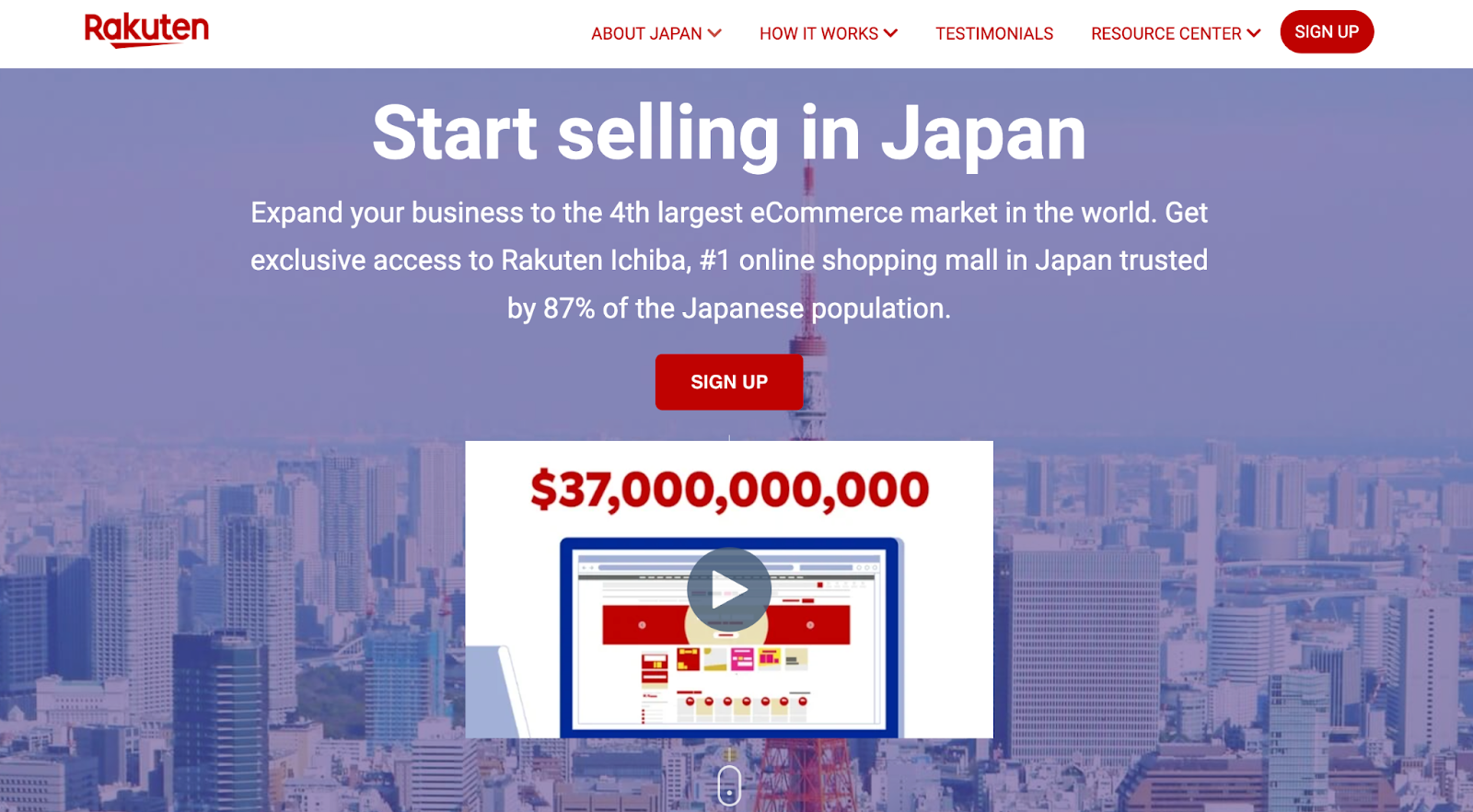
Japan-based Rakuten has a customer base of 1.6 billion members, and products include electronics, fashion, and pet supplies. In order to sell on Rakuten, merchants must apply and be approved. Brands can customize storefronts to create brand identity on the platform and attract customers.
Monthly visits: 1.45 billion
Fees: Monthly fee, $0.99 listing fee per item, commission charge between 8% and 20%
Top regions: United States, Japan, France, Canada, Taiwan
Top categories: Electronics; home and outdoor; clothes and shoes; sports and fitness; bags and luggage; pet supplies
9. Etsy
Another North American ecommerce marketplace, Etsy mostly serves the arts and crafts community, specializing in handmade, vintage, and collector’s items.
If you’re a craft-based small business, it makes a lot of sense to list products on Etsy, which is very easy to do: Just create an account and start listing. Etsy charges you a listing fee, but overall, the fees are lower than some of the other marketplaces mentioned in this article.
Monthly visits: 1.24 billion
Fees: $0.20 listing fee, 6.5% transaction fee, 3% + $0.25 payment processing fee
Top regions: United States, United Kingdom, Canada, Germany, France
Top categories: Jewelry; wedding items; party supplies; vintage items; clothing; home and living
10. Mercado Libre
Mercado Libre is a massive online retailer and payments ecosystem in Latin America. Founded in Argentina in 1999, Mercado Libre has become Amazon’s largest competitor in the region.
According to its Q2 2024 presentation for shareholders, the ecommerce marketplace generated $5.1 billion in ecommerce revenue in the quarter alone, a 42% year-over-year increase.
Monthly visits: 73.07 million
Fees: Varies between country and category, but can be upward of 16% per order
Top regions: Brazil,Argentina, Mexico, Chile, Colombia, Uruguay
Top categories: Smartphones; home and garden; sporting goods; fashion; and electronics and accessories
11. Shopee
Shopee is an ecommerce company headquartered in Singapore and a subsidiary of Sea Group, founded in 2015. Initially focused on mobile shopping, Shopee has since expanded into a leading ecommerce platform in Southeast Asia and Taiwan, with notable traction in Latin American markets as well.
Monthly visits:2.9 million
Fees: Rates vary from 3% to 5%, with additional commission fees depending on the category
Top regions: Indonesia, Malaysia, Thailand, Philippines, Taiwan, Singapore, Brazil
Top categories: Fashion; health and beauty; electronics; home and living; toys, kids, and baby products
12. Wayfair
Wayfair is a top online marketplace based in Boston, Massachusetts, specializing in home goods and furniture. Founded in 2002 by Niraj Shah and Steve Conine, the company has become one of the largest online destinations for home furnishings and décor in North America and parts of Europe.
Monthly visits: 84 million
Fees: Wayfair operates on a wholesale model rather than taking seller fees, as products are sourced directly or through exclusive partnerships.
Top regions: United States, Canada, United Kingdom, Germany, Ireland
Top categories: Furniture; home décor; kitchen and dining; outdoor furniture; bed and bath products
Benefits of selling on ecommerce marketplaces
Some benefits of selling on most ecommerce marketplaces include:
- Gaining access to millions of customers: Where do customers often go to start their shopping? Marketplaces. Listing your items on eBay, for example, gives you access to a customer base of 187 million. Walmart now sees 410.5 million monthly visits, and Amazon has over 2.4 billion visits per month.
- Visibility and brand awareness: Marketplaces can also help you access new audiences. Brands sometimes worry about people buying their products on marketplaces instead of their own sites—but the fact is, without visibility in marketplaces, you may not get many of those customers in the first place. Your next move could be to build a strong relationship with these new customers and help transition them from a marketplace to your own website.
- Gaining trust: When you sell on a marketplace, you are the beneficiary of its marketing and brand-building. Consumers tend to trust marketplaces, which helps your online business have a built-in level of trust.
- Testing ground: Do you want to know what people are willing to spend on a product? Do you have a surplus, or want to introduce a new product? Use a marketplace instead of your own online store to test out what works and what doesn’t.
- Going global: Most marketplaces operate internationally. When selling your products on a country-specific marketplace you can expand your reach to other countries with minimal effort.
Tips for selling on top online marketplaces
1. Choose the right ecommerce marketplace for your brand
As tempting as it might be to list your products on every single marketplace, you want to focus on platforms that are a good fit for your products. Each marketplace has its own nuances, rules, and audience.
Some platforms take a commission on every sale. Others charge you a listing fee. In each case, you’ll need to weigh the costs and benefits of getting access to a certain marketplace’s customers.
Here are a few characteristics of ecommerce marketplaces that will help you narrow down your choices:
- Products: Some marketplace retailers may be more niche than others, or may not allow the sale of products in particular categories (like medical devices). Research your potential marketplaces to see if your product can be sold there.
- Marketplace fees: It’s not just the selling and transaction fees and the commission structure you’ll need to contend with: Remember to check out shipping costs, if they’re not included, as well as any chargeback or refund fees.
- Customer location: If you’re primarily looking to sell online in the United States, it makes sense to use a marketplace US customers are familiar with, such as Amazon or eBay. If you’re looking to sell to customers in Asian markets, then you’d be better served by Alibaba or Taobao.
- Competition: While listing on a marketplace should help you get ahead of those who don’t—remember, potential customers do their initial product searches on marketplaces—you’ll be up against hundreds, sometimes thousands, of other vendors. Consider whether you want to search for a more niche marketplace before going head-to-head against other vendors on big marketplaces.
2. Use advertising strategies
Advertising on marketplaces like Amazon is on the rise. Each platform has its own rules and guidelines for advertising, but if you plan to pay for placement, prepare by doing the following:
- Prep inventory: Running ecommerce marketplace ads can lead to a quick boost in online sales. Set up an automated inventory management system to keep stock levels balanced. Make sure your fulfillment center is staffed properly, or work with a 3PL.
- Create a pricing strategy: You’ll be competing heavily on price when advertising in a marketplace.
- Craft product content that’s informational, helpful, and customer friendly.
It’s necessary to consider profitability trade-off. Conduct a cost-benefit analysis of the addressable ecommerce market that ads will reach on a specific marketplace. Knowing what level of margin you’ll accept can help you maximize the value of your ad spend.
3. Optimize product listings
Once you have a marketplace to display your products, treat product listings like your own website. Showcase your brand and introduce products how you want. If you’re selling on multiple marketplaces, consider a management platform to manage everything at once.
Experiment with product titles and descriptions for specific search queries—shoppers will see your title first before deciding to click on your listing or not. Each marketplace has its own ranking principles and SEO. Test and experiment with what works best to help you show up for select queries.
4. Offer top products
Ecommerce marketplace algorithms boost high-performing products to the top of search engines. Products that get many great reviews and are purchased repeatedly are more likely to show up for shoppers. Your offerings also shape consumer perceptions of your brand and your global marketplace performance. Consider listing top-performing products from your store versus a brand-new style that has zero traction.
5. Create a good customer experience
Give cross-border customers the same visibility and courtesy you would to local customers. While online selling sites may restrict certain elements like customer identities and branding opportunities, you can still create a good online shopping experience.
Socol recommends:
- Offering pricing in shoppers’ home currency
- Offering human-curated translations
- Showing total landed cost expectations (including duties and taxes)
- Showing shipping and delivery expectations
Start selling globally today
If an omnichannel brand wants to be everywhere its customers are, that includes expanding through marketplaces—often globally. Most people don’t start searching for products on Google or retail websites—they start on ecommerce marketplaces.
As you can see, there is no shortage of marketplaces for ecommerce brands. These websites can help you expand your brand awareness, reach new markets, and drive retail ecommerce sales.
Read more
- B2B Marketplaces: Top 6 Wholesale Marketplaces to Find Buyers
- B2B Ecommerce Apps: Top Solutions for Business Leaders
- Global Ecommerce Statistics: Trends to Guide Your Store in 2025
- What Is B2B Ecommerce? Examples and How to Start
- How To Improve Time to Market on a New Ecommerce Platform
- Multichannel Selling: How To Decide on Sales Channels for Your Business
- Four Successful Multichannel Ecommerce Strategies
- Ecommerce Pricing Strategies: A 2025 Comparison
- Cross-Border Ecommerce: Tips for Selling in Foreign Markets
- What is Social Commerce? Trends and Key Insights
Global ecommerce marketplaces FAQ
Is Shopify an online marketplace or ecommerce platform?
Shopify is an ecommerce platform. It helps merchants create and manage their own online stores and connect with various sales channels, including marketplaces and social media sites.
What is an example of a marketplace?
One example is the Amazon marketplace. It also acts as an online platform that sells products from third-party vendors. Another example is eBay, a global online auction and shopping website.
What are the advantages of using a marketplace?
Using a marketplace allows for greater visibility for businesses and access to additional customers. It also helps businesses increase their reach without building their own ecommerce site.
What are the best ecommerce marketplaces?
The best platform depends on the product you are selling and the target audience. Amazon, eBay and Etsy are some of the most popular ecommerce marketplaces.


